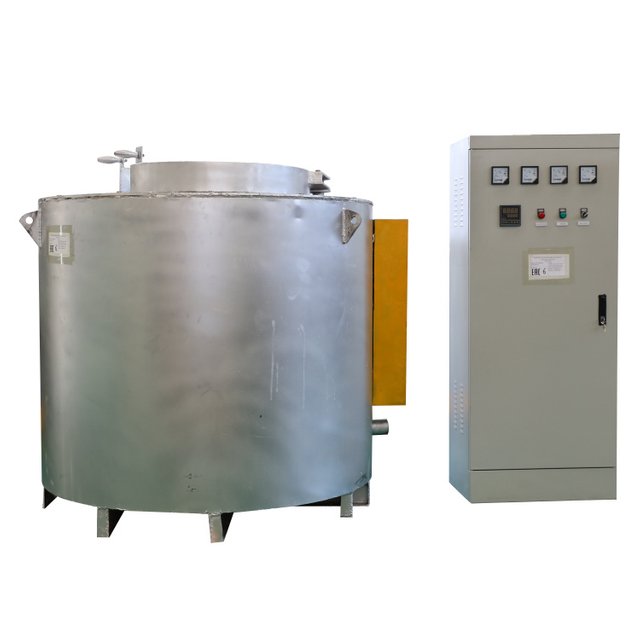Induction furnace supporting equipment
The supporting equipment of the induction furnace varies according to its type (such as industrial frequency induction furnace, medium frequency induction furnace, etc.) and specific application requirements, but generally includes the following main parts:
Email : [email protected]
WeChat/Whatsapp : 86-17538889778
Tel : 86-379-65188091

I. Electrical system
Power supply and electrical control part:
Power transformer: converts the grid voltage into a voltage suitable for the operation of the induction furnace.
Main contactor: controls the main switch of the power supply to ensure the safe on and off of the circuit.
Capacitor bank (including balancing capacitor, compensation capacitor, etc.): used to improve the power factor of the circuit and improve energy utilization efficiency.
Electrical control console: centrally controls the electrical system of the induction furnace, including operations such as starting, stopping, and adjusting power.
II. Furnace body
Induction furnace body: contains the induction coil, which is the core component for heating or melting. The induction coil is usually wound by copper tube, and cooling water is passed inside to prevent overheating.
Furnace lining: located inside the induction furnace body, used to protect the furnace body and withstand high temperature. The lining material is selected according to the type and temperature requirements of the smelting metal, such as refractory bricks, refractory concrete, etc.
Crucible: used to hold the metal material to be melted. Crucible materials need to be resistant to high temperatures, corrosion, and have good thermal conductivity.
- Cooling system
Cooling water system: including water pumps, cooling towers (or cooling water pools), pipes, valves, etc. Used to circulate cooling water to cool heat-prone components such as induction coils and capacitors to ensure the safe operation of the equipment.
Cooling water temperature and flow monitoring: Real-time monitoring of the temperature and flow of cooling water to ensure that the cooling effect meets the requirements.
- Transmission device (applicable to induction furnaces that require tilting or stirring)
Tilting device: used to pour the molten metal out of the furnace. The tilting device is usually driven by a hydraulic system or a mechanical transmission system.
Stirring device (if equipped): used to stir the metal liquid during the smelting process to promote uniform composition and gas discharge.
- Other auxiliary equipment
Feeding device: used to add metal materials to the furnace. The design of the feeding device needs to consider factors such as material shape, size and feeding speed.
Smoke exhaust device: used to remove smoke and harmful gases generated during the smelting process to keep the working environment clean and safe.
Safety protection system: including overheat protection, overcurrent protection, undervoltage protection and other protection functions, to ensure that the equipment can automatically shut down and alarm under abnormal conditions.
VI. Industrial computer system (optional)
Industrial computer system: used for parameter setting, workpiece status display, fault alarm and other functions. Through the industrial computer system, users can monitor the operating status of the induction furnace in real time and perform precise control.
In summary, the supporting equipment of the induction furnace is a complex system, and the various components cooperate with each other to ensure the safe and efficient operation of the induction furnace. In actual applications, users need to select appropriate supporting equipment according to specific needs and operate and maintain them strictly in accordance with the operating procedures.
VII. Maintenance and troubleshooting
Proper maintenance of the induction furnace and its supporting equipment is crucial to ensure its longevity and efficiency. Regular inspections should be conducted to check for any signs of wear and tear, leaks in the cooling system, or any other potential issues. Cleaning the induction coil and furnace lining regularly is also important to prevent buildup of impurities and ensure optimal performance.
In case of any malfunctions or breakdowns, troubleshooting should be carried out promptly to identify the root cause of the problem. This may involve checking the electrical connections, cooling system, or other components for any faults. It is important to follow the manufacturer's guidelines for troubleshooting and seek assistance from qualified professionals if needed.
Additionally, training operators on the proper operation and maintenance of the induction furnace and its supporting equipment is essential to prevent accidents and ensure smooth operation. This includes proper handling of the feeding device, monitoring of cooling water temperature and flow, and understanding the safety protection system.
By following proper maintenance procedures and troubleshooting protocols, users can maximize the efficiency and lifespan of their induction furnace and supporting equipment, ultimately leading to cost savings and improved productivity in their operations.